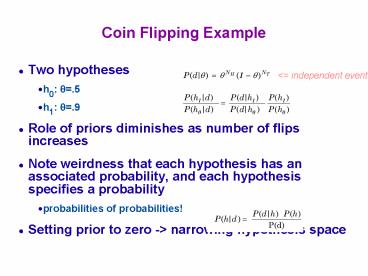Coin Flipping Example - PowerPoint PPT Presentation
1 / 15
Title:
Coin Flipping Example
Description:
Coin Flipping Example. Two hypotheses. h0: ?=.5. h1: ?=.9. Role of priors ... Note weirdness that each hypothesis has an associated probability, and each ... – PowerPoint PPT presentation
Number of Views:495
Avg rating:3.0/5.0
Title: Coin Flipping Example
1
Coin Flipping Example
- Two hypotheses
- h0 ?.5
- h1 ?.9
- Role of priors diminishes as number of flips
increases - Note weirdness that each hypothesis has an
associated probability, and each hypothesis
specifies a probability - probabilities of probabilities!
- Setting prior to zero -gt narrowing hypothesis
space
lt independent events
2
Probability Densities
- For discrete events, probabilities sum to 1.
- For continuous events, probabilities integrate to
1. - e.g., uniform density
- p(x) 1/r if 0 lt x lt r 0 otherwise
- Probability densities should not be confused with
probabilities. - if p(Xx) is a density, p(Xx)dx is a probability
the probability that x lt X lt xdx - Notation
- P(...) for probability, p(...) for density
3
Probability Densities
- Can treat densities as probabilities, because
when you do the computation, the dx's cancel - e.g., Bayes rule
4
Using the Posterior Distribution
- What do we do once we have the posterior?
- maximum a posteriori (MAP)
- posterior mean, also known as model averaging
- MAP vs. Maximum likelihood
- p(? d) vs. p(d ?)
5
Infinite Hypothesis Spaces
- Consider all values of ?, 0 lt ? lt 1
- Inferring ? is just like any other sort of
Bayesian inference - Likelihood is as before
- With uniform priors on ? andwe obtain
- This is a beta distribution Beta(NH1, NT1)
6
Beta Distribution
7
Incorporating Priors
- Suppose we have the prior distribution
- p(?) Beta(VH, VT)
- Then posterior distribution is also Beta
- p(?d) Beta(VHNH, VTNT)
- Example of conjugate priors
- Beta distribution is the conjugate prior for a
binomial or Bernoulli likelihood
8
(No Transcript)
9
Latent Variables
- In many probabilistic models, some variables are
latent (a.k.a. hidden, nonobservable). - e.g., Gaussian mixture model
- Given an observation x, we might want to infer
which component produced it. - call this latent variable z
z
?
x
10
Learning Graphical Model Parameters
- Trivial if all variables are observed.
- If model contains latent variables, need to infer
their values before you can learn. - Two techniques described in article
- Expectation Maximization (EM)
- Markov Chain Monte Carlo (MCMC)
- Other technique that I don't understand
- Spectral methods
11
Expectation Maximization
- First, compute the expectation of z given current
model parameters ? - P(Zz x, ?) p(x z, ?) P(z)
- Second, compute parameter values that maximize
the joint likelihood - argmax? p(x, z ?)
- Iterate
- Guaranteed to converge to a local optimum of p(x
?)
12
MCMC Gibbs Sampling
- Resample each latent variable conditional on the
current values of all other latent variables - Start with random assignments for the Zi
- Loop through all latent variables in random order
- Draw a sample P(Ziz x, ?) p(x z, ?) P(z)
- Reestimate ? (either after each sample or after
an entire pass through the variables?). Same as M
step of EM - Gibbs sampling is a special case of
Metropolis-Hastings algorithm - make it more likely to move uphill in the overall
likelihood - can be more accurate/efficient than Gibbs
sampling if you know something about the
distribution you're sampling from
13
(No Transcript)
14
Important Ideas in Bayesian Models
- Generative models
- Consideration of multiple models in parallel
- Inference
- prediction via model averaging
- importance of priors
- explaining away
- Learning
- distinction from inference not always clear cut
- parameter vs. structure learning
- Bayesian Occam's razor trade off between model
simplicity and fit to data (next class)
15
Important Technical Issues
- Representing structured data
- grammars
- relational schemas (e.g., paper authors, topics)
- Hierarchical models
- different levels of abstraction
- Nonparametric models
- flexible models that grow in complexity as the
data justifies - Approximate inference
- Markov chain Monte Carlo
- particle filters
- variational approximations































